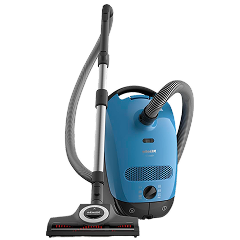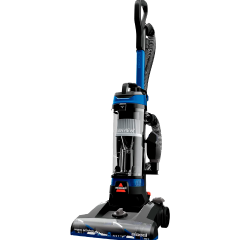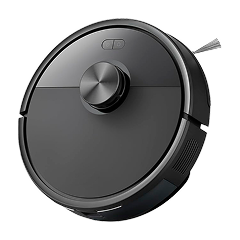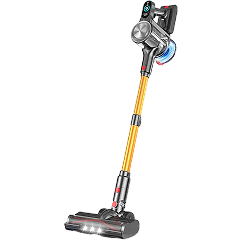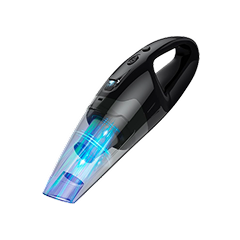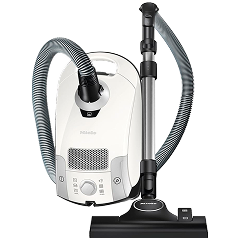A canister vacuum offers the advantage of allowing you to clean tight spaces without sacrificing power. They also tend to be compatible with a wide array of attachments, often carrying them onboard for easy organization.
If you’re interested in purchasing one but aren’t sure where to start, don’t worry. I’ve been testing and writing about vacuums for over a decade, and I want to share what makes a good canister vacuum, what kind of features are out there, and what you expect from the best-selling brands.
How to Choose the Right Upright Vacuum
Does weight matter?
Weight is a nuanced matter when it comes to vacuums. For the vast majority of people, lighter is better. A heavier vacuum does not mean better quality, higher suction, or a more durable product. And a vacuum that tips the scale harder will be more difficult to push, more fatiguing to carry up stairs, and generally make you want to use it less.
If you’re planning on carrying the canister up and down the stairs, be sure it has a handle; bonus points if it’s wrapped in rubber or textured for extra comfort.
Cleaning power
Cleaning power is an important metric for a vacuum, but it can be complicated and vague. There are two categories that measure a vacuum’s motor: suction and wattage.
Wattage is the flow of electricity over time. So a 1,000-watt motor draws more power than a 100-watt motor. It also means that a 1,000-watt motor has more cleaning potential than a weaker motor, but that it’s not a seamless translation. Imagine a car with a powerful motor. A powerful motor creates the potential for a very high top speed. However, if all the tires are flat, you’re not going to get anywhere fast.
The same is for a vacuum. A powerful motor needs to be paired with a well-sealed chassis to prevent leakage, a well-designed brush head for dirt pick up, and a clean filter to assure air flow. When all these aspects line up, you get a strong partial vacuum, also known as suction.
For uprights, canisters, and some cordless vacuums, that suction is measured in air watts. Air Watts are calculated by multiplying suction power by airflow and dividing that number by 8.5.
For canister vacuums, an air watt rating between 200-250 AW and above 1,000 watts is probably going to get the job done.
Filter types
The most common type of filter is the High-Efficiency Particulate Air or HEPA filter. These are filters that are made from fiberglass, and they strain out small particulates from the air. To be called HEPA, a filter must be able to remove at least 99.97% of particulates greater than .3 microns in diameter. There are several grades higher than that, but this is the minimum.
You may encounter a vacuum that claims to have HEPA-like filters. These are filters that are similar, but don’t meet HEPA standards.
Vacuum brands like Shark also include additional pre-filters. These are foam and mesh filters designed to keep larger particulates like hair from clogging the more expensive HEPA filter, so you can get more use out of it. Pre-filters are often washable.
Changing out your vacuum’s filters regularly will help maintain the longevity of the device. Anyone who’s interested in increasing the air quality in their home and making sure their vacuum doesn’t put dust back into the air, a certified HEPA filter is the gold standard.
Bagged vs Bagless
The majority of canister vacuums use bags. However, there is a growing desire for bagless models.
The trade-off between bagged and bagless comes down to hygiene versus convenience. The bag itself acts as an additional layer of filtration. Some bagless models compensate by including an additional filter, usually made from mesh or foam.
Bagged vacuums are also more hygienic when it comes to emptying. When you toss the dirt bag away, it won’t cause a dust plume that you get when you open the dirt container of a bagless vacuum. There’s also the added benefit if you’re the type of person who doesn’t like to see, touch, or smell anything unpleasant; the bag helps conceal all that from you.
Bagged vacuums have larger dirt capacities than bagless vacuums. That means emptying less often. However, the consequence of that is that bagged vacuums can get a certain bad odor from the dirt, dust, crumbs, and hair sitting in the bag for months at a time. Dirt cups can also develop that smell, but you can also wash them.
Bagless vacuums have the advantage of peace of mind of never having to worry about finding compatible bags. Also, some people really like having a view of all the dirt their vacuum suctioned up.
Noise Level
One of the major advantages of canister vacuums is that they often have a Quiet Mode, especially on the higher end. If you ever felt like your upright vacuum was too loud, you should check out a canister vacuum that lists a Quiet Mode. In my experience, they tend to be 25% quieter.
Brushroll Types
There is also the question of what the brush head is made of. The best brush heads tend to be made of a combination of fluffy and stiff bristles. The fluffy material, usually nylon, is great at removing fine dust that adheres to hardwood. Imagine a mechanized dusting cloth. The stiffer bristles act more like a broom to sweep up larger debris and beat dust out of carpets.
On the more niche front, there are brush heads that are designed to resist hair tangles. This is great for people with pets or a household where one or more members have long hair. And the specialized features don’t stop at the brush head.
Storage
The best canister vacuums have onboard storage. You pop open the lid like you would to change the bag, and there is an area where the minibrushes and other attachments can be placed.
This is important because one of the advantages of a canister vacuum is the ability to quickly swap out the main brush head for a cleaning attachment. Having them close at hand means you’re more likely to use them, which results in getting more value out of your vacuum.
Attachments
My top three must-have attachments are: the crevice tool, dusting brush, and a mini-brush, preferably motorized.
The crevice tool is sometimes combined with the dusting brush. It’s characterized by having a narrow tip that lets you clean tight spaces. The dusting brush’s bristles allow you to clean around delicate objects.
A mini-brush is a versatile tool that can effectively clean stairs and upholstery. Most mini-brushes are not powered, relying on the air flow of the vacuum’s suction to spin. This is most common on full-sized uprights and canisters.
Some models, like the Kenmore 600 Series canister, have electricity running through its hose, which translates to a powered attachment. However, it’s very common for cordless vacuums to have powered mini-brushes.
Beyond the must-haves, I have a few choice nice-to-haves. I like the idea of a spare dusting or a dedicated upholstery brush. If you regularly clean surfaces like pet beds, it’s nice to have a spare brush to avoid cross-contamination.
I’m also a fan of telescopic wands. Not only do they provide extra reach when you need it, but they can also help adjust your canister or cordless vacuum to a comfortable everyday use height.
Ease of cleaning
For manual vacuums, the ease of cleaning usually boils down to the synergy between the motor and the brush roll, swivel joints, and the placement of the handles. When a vacuum’s motor works well with the brush roll, you get the feeling that the unit is self-propelled. Motors with higher wattages are more likely to have this effect.
Vacuums that advertise swivel or ball joints are also going to be easier to clean with. These joints allow the vacuum to twist and turn on a dime in order to clean around corners and furniture better.
Finally, vacuums with a secondary handle somewhere on the body are more likely to be of higher quality. Having extra and well-placed handles allows you to carry it up the stairs or out of storage.
What are some good vacuum cleaner brands?
Miele
If you’ve ever felt frustrated by your upright tipping over when using the hose attachments, Miele solved this problem by adding weights to ensure stability. The canisters often have a ton of built-in cleaning modes like Quiet Mode and a Drapes setting, so you don’t need to play a guessing game when cleaning.
Overall, my experience testing Miele vacuums makes me think they are well worth the investment. However, they are expensive, and the selection is increasingly getting narrower. When I first started testing Miele vacuums ten years ago, there were significantly more models and packages. So if you saw a model in the past you wanted to check out again, it’s likely gone from the retail market.
Shark
While not strictly a canister vacuum, the most popular Shark uprights can detach from their brush heads to become a wheelless canister.
Shark vacuums also tend to come with a full set of attachments and washable prefilters.
On the price front, Shark covers the middle to upper spectrum. You can get a new upright with the lift-away feature for under $200. To get every feature that Shark offers, including a vacuum that adds a pleasant scent to the air, an attachment that can clean the underside of couches and fridges, you’re going to be looking to spend around $500.
The final point in Shark’s favor is that the company covers its models with a robust five-year warranty.
In my experience, Shark is very responsive to consumer wants, so popular models stay in stock while those that don’t sell well disappear very quickly. The company’s manufacturing base is robust, so parts also always seem available.
Kenmore
Kenmore has been associated with the Sears brand for almost a century; however, they are now mostly sold on Amazon.
The company’s canister vacuums set the standard for the type. They have excellent suction and extra-wide brush heads that make short work of large carpeted rooms. They also have access to well-engineered attachments like the mini-brush Pet PowerMate that is specially designed to get pet hair off upholstery.
I’ve tested half a dozen Kenmore canisters, and they all had onboard storage, telescopic wands, and comfortable carrying handles. This winning combination made me want to use them and not keep them tucked away in the closet.
Common Mistakes People Make When Purchasing a Vacuum
Picking price over quality
It’s really easy to choose a product on price alone. We’re all feeling the mounting pressure of inflation. However, if you invest in quality now, it’s going to pay dividends in the long run. Yes, it’s important to shop within your means, but it’s also equally important to shop to meet your needs.
For example, let’s say you have a home with a dog that sheds a lot. If you go for the cheapest vacuum, you may end up wasting hours of time, cutting tangled fur out of the brush roll just to get it to run. Instead, invest a little more and get a vacuum with an anti-tangle brush head that can actually keep your pet’s hair at bay.
Not considering your floor type and floor plan
Different types of vacuums have different types of brushes. Wide and stiff bristles are better suited for cleaning carpets. Soft bristles that are more akin to microfiber are better at getting fine dust off bare floors. And some flooring, like wood laid in the parquet style, can be damaged by using the wrong vacuum.
You should also consider cord length. Make sure that the cord length is compatible with your room sizes and outlet placement. You don’t want to be in a situation where you have “dead zones” in your house where your vacuum can’t reach without dragging out an extension cable.
Not thinking about your own physicality
Yes, you want to get a vacuum that suits your home, but what about your body? A big, full-sized vacuum might be very powerful. However, it also might be heavy and difficult to carry up the stairs, especially if it lacks a well-placed handle. A large cleaning width makes short work of rooms, but you might not have considered the amount of furniture you’ll have to move.
On the flipside, if you’re tall, you might want to get a vacuum with a telescopic wand so it can extend and be more comfortable in your hand.


